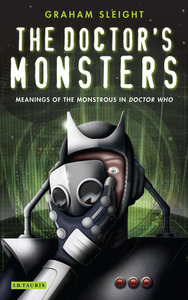Take a photo of a barcode or cover
2 reviews for:
The Doctor's Monsters: Meanings of the Monstrous in Doctor Who
Paul Cornell, Graham Sleight
2 reviews for:
The Doctor's Monsters: Meanings of the Monstrous in Doctor Who
Paul Cornell, Graham Sleight
http://nwhyte.livejournal.com/2052893.html[return][return]Fellow fans will enjoy Sleight's take on the various creatures, whether we agree or disagree - for instance, he argues that if Kroll had been realised better on screen, The Power of Kroll might have a far better reputation as a story. But mainly he looks at the effect of monsters on the other characters in the story, on the viewer and to an extent on themselves. The people who will really get something out of this book are those with a strong interest in cinematic and television depictions of monsters, combined with a passing familiarity with Who, rather than the other way round.Having said that, the book looks very much at Who in its own terms without tying it particularly to other screen sf or fantasy, and jumps around quite a lot in historical timeline (which I think was a good way of getting the Whovian reader to think about it a bit more; the non-Whovian reader won't care). The Daleks get four separate chapters - original story, pre-Davros, post-Davros and New Who - and the Cybermen get three - up to Return of the Cybermen, Earthshock to end of Old Who, and New Who. [return][return]My copy unfortunately was marred by production errors, including a complete lack of page numbers. The material deserved better from the publisher (I.B. Tauris), but Who fans and media fans more generally will enjoy it anyway.
This wasn't the book I wanted it to be -- it's less a critical analysis of the monsters in Doctor Who than an illustrative introduction to the idea that they might be analysed at all, bolstered by synopses of the stories they appear in. There's nothing by way of close reading, only very general observations (many of them familiar) about what the monsters represent.
On this basis, though, it's very readable and I galloped through it.
There are some editing and formatting issues -- in particular parenthetical comments are punctuated by commas rather than brackets or dashes, which becomes very irritating after a while, and having stated that it will distinguish between asterisks and plus-signs for particular uses, the book instead uses plus-signs throughout (even, amusingly, when illustrating what an asterisk looks like). That feels slipshod, but is a case of the author being ill-served by the editor and publisher rather than something that can be laid at his own door.
It's a decent enough lightweight read, but it won't rock the world of anyone who's read a critical book about Doctor Who before.
On this basis, though, it's very readable and I galloped through it.
There are some editing and formatting issues -- in particular parenthetical comments are punctuated by commas rather than brackets or dashes, which becomes very irritating after a while, and having stated that it will distinguish between asterisks and plus-signs for particular uses, the book instead uses plus-signs throughout (even, amusingly, when illustrating what an asterisk looks like). That feels slipshod, but is a case of the author being ill-served by the editor and publisher rather than something that can be laid at his own door.
It's a decent enough lightweight read, but it won't rock the world of anyone who's read a critical book about Doctor Who before.

